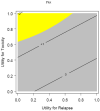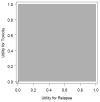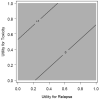Quality-adjusted survival analysis of Radiation Therapy Oncology Group (RTOG) 90-03: phase III randomized study comparing altered fractionation to standard fractionation radiotherapy for locally advanced head and neck squamous cell carcinoma
- PMID: 19107946
- PMCID: PMC2628953
- DOI: 10.1002/hed.20949
Quality-adjusted survival analysis of Radiation Therapy Oncology Group (RTOG) 90-03: phase III randomized study comparing altered fractionation to standard fractionation radiotherapy for locally advanced head and neck squamous cell carcinoma
Abstract
Background: To evaluate quality-adjusted survival (QAS) of patients with locally advanced squamous cell carcinoma of the head and neck treated with 4 different radiation fractionation schedules.
Methods: QAS was calculated using the quality-adjusted time without toxicity or relapse (Q-TWiST) methodology. Utilities (patient preferences for certain health states) were obtained by threshold analysis. Q-TWiST therefore equaled TWiST + ([weight for toxicity] x [time spent in toxicity]) + ([weight for relapse] x [time spent in relapse]).
Results: A statistically significant increase in QAS existed for patients treated with hyperfractionated radiotherapy compared with standard fractionated radiotherapy (SFX) with a toxicity utility > or = 0.57 and relapse utility < or = 0.72. No statistically significant difference was observed for patients treated with the other 2 fractionation schedules compared with SFX.
Conclusion: Q-TWiST analysis identified patient groups that would benefit from more aggressive therapy. Further investigation with patient-generated utilities is needed.
Figures







References
-
- Regine W, Scott C, Murray K, et al. Neurocognitive Outcome in Brain Metastasis Patients Treated with Accelerated Fractionation (AF) vs. Accelerated Hyperfractionation (AH) Whole Brain Radiotherapy (WBRT): An Analysis from Radiation Therapy Oncology Group (RT)G) Study 91-04. Int J Radiat Oncol Biol Phys. 2000;48:158–159. - PubMed
-
- Choucair A, Scott C, Urtasun R, et al. Quality of Life and Neuropsychological Evaluation for Patients with Malignant Astrocytomas. RTOG 91-14. Int J Radiat Oncol Biol Phys. 1997;38(1):9–20. - PubMed
-
- Johnson D, Scott C, Marks J, et al. Assessment of Quality of Life and Oral Function of Patients Participating in a Phase II Study of Radioprotection of Oral and Pharyngeal Mucosa by the Prostaglandin E1 Analoge Misoprostol (RTOG 96-07) Int J Radiat Oncol Biol Phys. 2001;51:97. - PubMed
-
- Scott C, Stern J, Asbell S, et al. Age and Marital Status Linked to Quality of Life of Long Term Survivors of Head and Neck or Prostate Cancer: Report from a Survey of Radiation Therapy Oncology Group Patients. Int J Radiat Oncol Biol Phys. 2001;51:98.
-
- Fisher J, Scott C, Fu K, et al. Treatment Patient and Tumor Characteristics Impact Quality of Life (QOL) in Patients with Locally Advanced Squamous Cell Cancer of The Head and Neck: Report of The Radiation Therapy Oncology Group (RTOG) Trial 90-03. Int J Radiat Oncol Biol Phys. 2001;51:98.
Publication types
MeSH terms
Grants and funding
LinkOut - more resources
Full Text Sources
Medical

